The Value of Stone Wool Acoustical Ceilings
A proven, natural building material is now used in ceilings providing high-performance acoustics and smooth, clean surfaces
![]() Continuing Education
Continuing Education
Use the following learning objectives to focus your study while reading this month’s Continuing Education article.
Learning Objectives - After reading this article, you will be able to:
- Differentiate between the properties of natural material-based stone wool ceiling tiles and other acoustical ceiling materials.
- Analyze and explore the fundamentals of interior acoustical design treatment and their relationship to green buildings and sustainable design.
- Assess the multiple qualities of stone wool acoustical ceilings that can contribute to green and sustainable building design.
- Recognize and identify the acoustic needs of different design applications and the attributes to look for, including contributions to green building certification.
Acoustical suspended ceilings are commonplace across many building types. Since the 1950s, they have been a preferred design choice due to their ability to conceal but still be accessible to HVAC ductwork, electrical wires, plumbing pipes, phone cables, security lines, and other components of commercial buildings. These suspended, interconnected ceiling systems use a metal grid comprised of cross tees and main runners in various profile sizes. Within that grid, acoustical tiles of different types provide the aesthetic and sound properties desired for a particular space. Although architects often think of traditional materials such as mineral fiber or fiberglass for those ceiling tiles, there is another option where the tiles are fabricated from natural stone wool. This product has impressive characteristics for fire rating, strength, acoustics, and sustainability, among others.
Overview: Stone Wool Ceiling Tiles
The idea of producing stone wool has its origins in the volcanic eruptions on the islands of Hawaii. Early native inhabitants discovered woolen-like strings of stone lying on the ground following these eruptions and attributed it to hair from the goddess, Pele. Modern geologists have identified it as primarily igneous basalt, the earth's most abundant bedrock. This natural stone wool has thus become understood to be formed by the rapid cooling of lava from eruptions on the sea floor which creates the thin strands of stone. The strands flare out randomly creating a non-directional pattern that provides some unique and valuable characteristics related to strength and stability. The recognition of the value of this stone wool has led producers to emulate and imitate the process to create building products out of manufactured stone wool.
Manufacturing Process
As a product, stone wool combines the traits of rock with the characteristics of typical fiber-based building products. The manufacturing process is based on using natural, inorganic basalt to create natural fibers with no blowing agent used. In addition, a number of other recycled secondary materials (e.g. sewage sludge ash from treatment of wastewater or residues from metal industry processes) are used to add to the overall properties of the finished product.

Photo courtesy of ROCKFON
Stone wool ceiling panels are a proven alternative choice for many different and exciting building spaces.

Photo courtesy of ROCKFON
Stone wool is made from natural volcanic basalt plus recycled secondary products and reclaimed material during manufacturing.
The typical production process for stone wool begins with the fusion of the volcanic basalt at a temperature of 2,732°F (1,500°C). The rock, secondary materials, and coke are automatically fed from the top of a cupola-style furnace. The melt runs out of the bottom of the furnace and onto a spinning machine, where stone wool is literally spun. Minor amounts of organic binder and oil are added to bind the stone wool together and to increase water repellency. The wool is then collected on a belt conveyor so its structure and density can be adjusted according to its final use as either a rigid panel product or a batt-style product. Either way, the wool fibers remain non-directional which is important for achieving many of the desired performance characteristics.
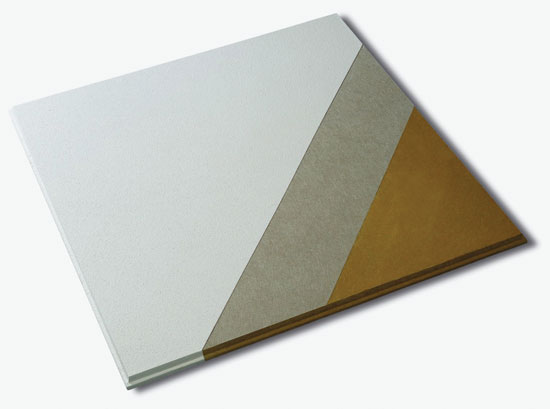
Photo courtesy of ROCKFON
Ceiling tiles made from stone wool have a non-directional acoustical stone wool core that is covered with a mineral fleece layer and then finished with a smooth water-based paint that creates an easy-to-clean surface.
In addition to acoustic ceiling panels, stone wool's unique combination of thermal, fire, and acoustic properties make it well suited for blown or batt insulation in cavity walls, board type of insulation for roofing installations, and pre-formed insulation pieces for faced pipe sections and wall slabs.
Once stone wool is formed into the more rigid panels, they move to a curing oven where the final properties are locked in the curing of the binder. Finishing of the ceiling panels relies on the use of a mineral fleece and water-based paint which are layered on top of the stone wool to produce the desired appearance.
Note that since stone wool is naturally porous and sound absorbent, there is no need to create fissures or holes to improve sound qualities. That means that the surface can look more uniform and smoother than many mineral fiber ceiling tiles. The finished panels then proceed on to formatting saws, where they are cut to specific tile sizes, and edge profiling equipment, where final edge profiles are formed. In certain cases, the panels could be diverted to specific custom finishing processes or be led to off-line equipment for special treatment. Once complete, the finished tiles are then gathered and packaged for shipment.
From an environmental standpoint, the off-gases of the production process coming from the furnace, spinning chamber, and curing oven are typically cleaned in filters and after-burners before entering the chimney, helping to assure a rather clean operation. Further, the waste inevitably created during the production is recaptured and reused since it is both fully recyclable and a valuable raw material.
Properties of Stone Wool Ceiling Tiles
Once completed, stone wool acoustic ceiling tiles generally have a density that is higher than fiberglass ceiling tiles, making them more rigid and durable. Additionally, stone wool exhibits a number of other superior properties when compared to other acoustical ceiling tile choices, which are summarized as follows:
Surface burning characteristics. UL 723 (ASTM E84) / CAN / ULC S102 is a standard method of testing for surface burning characteristics of particular building materials. The test is designed to determine the relative surface burning characteristics of materials under specific test conditions. Results are expressed in terms of Flame Spread Index (FSI) and Smoke Developed Index (SDI). Many commercial applications require an FSI of 25 or less and an SDI of 50 or less. Products labeled “FHC 25/50” (Fire Hazard Classification 25/50) or “Class A” (ASTM E1264) fulfill these requirements. Most stone wool ceiling panels in North America outperform the fire requirements for ceilings due to their non-combustible makeup.
Dimensional stability. This term is generally defined as the material's ability to retain its original shape when subjected to external forces such as varying degrees of temperatures, atmospheric pressures, moisture content, and/or other external stresses. Stone wool retains its manufactured characteristics unaltered over time with the particularly unique property of not expanding or contracting when subjected to changing heat or cold conditions. This has been commonly demonstrated using the ASTM C356 test for thermal expansion. For ceiling tiles, that means a tighter fit in the grid and tolerances can be maintained over time without concerns of the tile swelling or shrinking.
Humidity resistance. Humidity can weaken the structure of certain ceiling materials and cause them to sag. In extreme cases they may even fall out of the grid. This will often happen in buildings under construction where the building is not fully sealed, or materials have not dried out.
Additionally, humidity levels are naturally high in wet rooms like kitchens and sanitary areas, where moisture problems can occur. Stone wool is a hydrophobic material, meaning it does not absorb water and is not impacted by humidity. As such, stone wool ceiling panels have been found to be dimensionally stable at up to 100 percent relative humidity. That means that stone wool ceiling panels can be installed in the early stages of construction (when the windows are not fully sealed) without any risk of sagging.
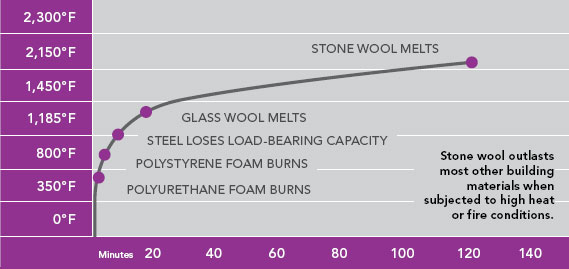
Image courtesy of ROCKFON
Stone wool outlasts most other building materials when subjected to high heat or fire conditions.
Mold and mildew resistance. Stone wool is water repellent and has no nutritional value. Hence, stone wool ceiling panels inhibit growth of mold and bacteria through their inherent material makeup. In healthcare buildings, they have also been shown to provide no sustenance to other harmful micro-organisms.
Impact resistance. High-usage areas can create heavy wear and tear on building materials, thus requiring impact-resistant ceiling panels. This is commonly true in settings like schools and gyms where ceilings in these kinds of areas need to be able to withstand tougher-than-average conditions as well as frequent access requirements. Special, reinforced stone wool ceiling tiles are available to address this need.
All of these properties are significant and important in the design of buildings. However, there is one more important aspect that we will delve more deeply into, namely the acoustical performance of ceilings.
Acoustics: Design Principles for Ceilings
The importance of acoustics is found in the ways that poor acoustics can affect human health and well-being. According to the National Institute for Occupational Safety and Health (NIOSH), high ambient noise levels in a room or space affect people's health by increasing general stress levels. Further, they find that continued exposure does not lead someone to adjust and “get used to it,” rather, the effects worsen.

Photo courtesy of ROCKFON
Indoor environments that are prone to generating noise need to address acoustics as a matter of human health and welfare.
The World Health Organization (WHO) (www.euro.who.int/en/health-topics/environment-and-health/noise) has noted that “noise seriously harms human health by causing short- and long-term health problems. Noise interferes with people's daily activities at school, at work, at home, and during leisure time. It can disturb sleep, causes cardiovascular and psychophysiological effects, hinder work and school performance, and provokes annoyance responses and changes in social behavior.” Peaks in sound or noise and a high level of average sound are what have been shown, over time, to damage an individual's health. Therefore, attention to acoustics is important for all environments, from factories to kindergartens, as a matter of the health and welfare of those who use those environments.
Sound is measured in decibels of pressure to indicate how loud it is in a room. The actual level in any particular room depends on the strength of the sound source (or sources) and the ability of a room or space to help control that sound. Sound sources can be desirable such as a person speaking or music playing but they can also be undesirable if undue echoes are caused or background noise is encountered. Since sound radiates from a source and moves through space in all directions, how it acts within a room will be a function of what it encounters. If there are a lot of sound-reflecting surfaces, then echoes and reverberation become noticeable. If there are a lot of sound-absorptive surfaces, then the sound is deadened and echoes are reduced. The size and shape of the room will similarly come into play as sound moves through it and create additional impacts.
Once airborne, sound doesn't necessarily stay within a room—it can readily pass through openings, transfer through ceilings, etc. In this case, it is the ability of a space to insulate itself from unwanted sound that is important. Background noise that enters a room can interfere with the desired sounds, thus creating unwanted noise. By the same token, desirable sound created within a given space can become unwanted noise once it passes through to other spaces. Hence, it is important for rooms to be appropriately designed to contain sound where it is desired and prevent its passage to places where it is not desired.
One of the measures of good acoustical performance is “speech intelligibility” which is defined simply as how well speech can be heard and understood in a room. Many factors influence speech intelligibility. These include the strength of the speech signal, the direction of the source sound, the level of background noise, the reverberation time (RT) of the room, and the shape of the room. A good reverberation time will enable a listener to hear and understand the first word, allowing that sound to die out before the sound of the next word reaches the listener.
Longer reverberation times can impair speech intelligibility since word sounds will overlap, creating garbled sounding words and poor verbal communication. Instructional spaces, such as classrooms, are best with short RTs—less than 0.6 second to ensure clarity and high speech intelligibility. Auditoriums, theaters, and other musical spaces will typically benefit from longer RTs, typically greater than 1.2 seconds. In addition to RT, if desirable sound is drowned in background noise, the listener will have difficulty understanding what is being said. The normal reaction is to speak louder, leading to more reverberation and poorer speech intelligibility.
Recognizing the importance of good acoustical design in schools in particular, ANSI Standard S12.60 “Acoustical Performance Criteria, Design Requirements and Guidelines for Schools” has been developed. This national standard is used as a basis for determining currently acceptable levels of acoustic performance in schools including appropriate RT and speech intelligibility thresholds. Stone wool ceiling tiles can be used as part of an overall acoustical design to work with the principles of sound and demonstrate compliance with the ANSI standard.
Sustainability: Green Building Contributions of Stone Wool Acoustic Ceilings
Earlier we identified the problems that too much or unwanted sound can create for people in a building. By comparison, the most important contribution to any sustainable building from an acoustic ceiling tile is the creation of sustainable working, learning, and healing environments through acoustic comfort. This has become recognized and formalized in the U.S. Green Building Council's (USGBC) LEED® rating system which contains a number of areas where ceilings can contribute to a higher LEED rating. While acoustic comfort will likely be the biggest contributor, there are also other areas worth noting that stone wool ceiling tiles can contribute to a green building design. This is true in both of the current versions of LEED that are in use, namely, LEED 2009 and LEED version 4 (v4).
Energy and Atmosphere
When designing an energy-efficient building, there is a tendency to focus on things like insulation and windows, but ceiling systems can also play a role in effective energy conservation. By using a ceiling system that has higher levels of light reflectance, less artificial light may be needed. Stone wool ceilings offer superior light reflection and diffusion. Typical acoustical ceilings have a Light Reflectance (LR) rating of 0.75, meaning that they reflect 75 percent of the light striking its surface. Most white stone wool ceilings reflect between 83-86 percent of available light. They have a homogenous surface without any visible holes or perforations, and their high diffusivity limits hot spots and glare for increased comfort. Combined, these qualities provide efficient utilization of both artificial and natural light sources which can save energy. This improves space illumination allowing for fewer light fixtures, a reduced electrical light output, lower maintenance costs, and reduced cooling load.
In LEED v4, there is also a credit in the Interior Design and Construction (ID&C) system for Design Flexibility which recognizes and rewards different strategies that increase the useful life of the project space. Interior ceiling systems that are movable or demountable can directly contribute to this credit along with accessible ceiling systems.
Materials and Resources
Under LEED 2009, Materials and Resources (MR) credit 4, Recycled Content, allows points for recycled material content in a new or renovated building. Stone wool products contain up to 84 percent recycled and natural stone content, with inorganic and combustible waste materials being the most important sources of secondary materials beyond the basalt. Additionally, high recycled content suspension systems and grids made from metals are also available.
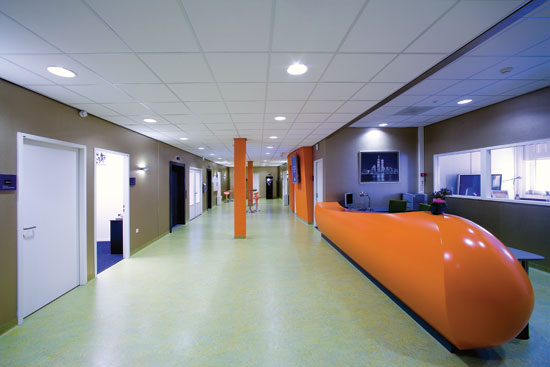
Photo courtesy of ROCKFON
Ceilings made from stone wool can contribute to sustainable construction by virtue of their natural and recycled content.
If LEED v4 is being used, there are new MR credits for Life-Cycle Impact Reduction generally with 2-5 rating points available. Stone wool ceiling tiles can often be shown to have a very positive life-cycle impact due to the natural and recycled content of the product as well as its ability to be re-used or recycled at the end of its service life. There are also new credits for Building Product Disclosure and Optimization which address Environmental Product Declarations (EPDs), responsible Sourcing of Materials, and Material Ingredients. Once again the natural and recycled makeup of stone wool can help in all of these areas.
Indoor Environmental Quality
There are a number of ways that ceilings can contribute to improved indoor environmental quality (EQ). We have mentioned how higher light reflectivity can aid in extending daylighting into the space. LEED v4 recognizes that fact as part of the Interior Lighting credit under Lighting Quality which allows designers to demonstrate compliance by identifying four specific strategies from a list of eight provided. Several of these strategies identify specific average surface reflectance levels of 85 percent for ceilings among other things over 90 percent of the regularly occupied floor area. Stone wool ceiling tiles are readily available that meet or exceed this 85 percent level.

Photo courtesy of ROCKFON
Indoor environmental quality can be enhanced by natural daylighting and ceilings with high reflectance levels.
Beyond the light quality EQ trait, the emissions from ceiling tiles are addressed under the Low Emitting Materials credit. Ceilings must be 100 percent compliant in order to qualify for credit and points. One way to show compliance is for the ceiling tile to carry a GREENGUARD certification which is owned by Underwriters Laboratories (UL) as part of the UL Environment portion of that organization. Some stone wool ceiling products are pre-finished and qualify as low-emitting materials since they use low VOC content in the ceiling panels or the grids. Further, no added paints, coatings, adhesives, or harmful sealants are typically needed for ceilings. Based on these qualities, some stone wool ceiling systems qualify for GREENGUARD Gold Certification (formerly known as GREENGUARD Children & Schools Certification). This higher level of certification uses stricter criteria, considers safety factors to account for sensitive individuals (such as children and the elderly), and ensures that a product is acceptable for use in environments such as schools and healthcare facilities. It is referenced by both The Collaborative for High Performance Schools (CHPS) and the LEED Building Rating System.
It is also within the EQ credit section where the role that acoustics can play in terms of indoor environmental quality is addressed. In particular, LEED v4 Building Design and Construction (BD+C) contains a prerequisite for schools and a credit possibility for improved acoustics in different building types. For schools ANSI Standard S12.60 is the cited basis for performance. This standard and the EQ inclusion comes from studies that have demonstrated that excessive reverberation and noise in a classroom interfere with speech intelligibility which directly affects a student's ability to learn. Direct Sound in this case is the sound of a teacher's voice traveling directly from the teacher to the student. This is always beneficial in terms of speech intelligibility because the direct sound is not affected by anything in the room, making speech clear and distinct. It is the reflected or reverberating sound and intruding noise that interfere with the Direct Sound.
LEED v4 addresses Reflected Sound by requiring that the ceiling (or equivalent area of other room surfaces) has a minimum Noise Reduction Coefficient (NRC) of 0.70. Alternatively, another option is to comply with maximum Reverberation Time per the ANSI standard. LEED v4 sets maximum permissible Background Noise from HVAC systems at 40 decibels for the prerequisite and a lower 35 decibels for the credit. For the optional acoustic performance credit, you will also need to isolate the classrooms from sound that is generated outside the classroom or even outside the building, such as playground activity, traffic, planes, etc. that generally intrudes into the classroom by way of the windows. This means building walls and floors/roofs that comply with the minimum Sound Transmission Class (STC) requirements in the ANSI standard.
Using stone wool ceiling systems that have the appropriate NRC rating plus ensuring proper reverberation performance for different areas of the building will be necessary in order to meet the prerequisite and the credit point in a LEED for school buildings. In addition to schools, LEED v4 BD+C rating systems include similar credits for acoustic performance in other facility types such as commercial buildings, data centers, hospitality, warehouses/distribution centers, and healthcare. High-performing sound-absorptive ceilings can be used to contribute to the overall acoustic design and earning LEED points in this IEQ category.
Design Versatility: Ceiling Tile and Grids
With an understanding of the multiple performance properties of stone wool ceilings, let's turn our attention to the design opportunities. Like all suspended ceiling systems, there are choices and options that can be selected to enhance or highlight particular building designs.
Tile sizes. Stone wool ceiling tiles are made in a variety of standard modular tile and plank sizes such as 2 feet by 2 feet and 2 feet by 4 feet but a range of other sizes are possible as well. These can be selected based on design preferences and laid out similar to any other suspended ceiling system. By combining different module sizes in different patterns, it is possible to create different design impacts.
Edges. As with other ceiling tiles, stone wool can be fabricated with a variety of edge treatments. The most common is a simple square edge design that allows the edges to rest directly on the “tee” portion of the grid. A tegular edge, whether square or angular, allows the tile to protrude below the grid and provide more depth and texture to the ceiling plane. Semi-concealed or fully concealed edges are possible when the rigid stone wool panels are fabricated to cover all or part of the tee face of the grid. It is also possible to avoid the use of a grid altogether and simply mount the ceiling tiles directly to a substrate using adhesive or other means.
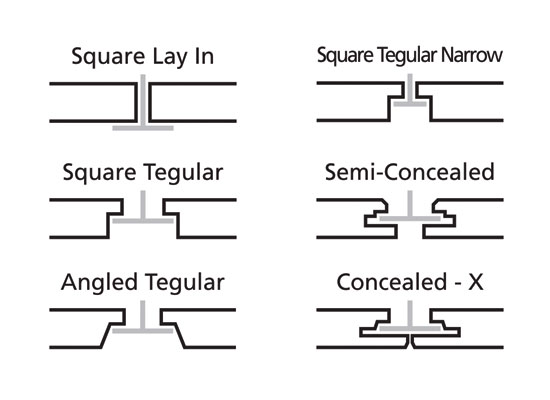
Image courtesy of ROCKFON
The edges of stone wool ceiling tiles can be selected from many standard choices to suit particular building design applications.
Color. The default color for all ceilings is white due to its reflective nature and recessive appearance. However, custom colors are possible when selecting stone wool ceilings. Lighter colors can still provide various degrees of light reflectance inside a space and may often be desirable. In other cases, a full range of darker or bolder colors are also available that can enhance the overall building design.
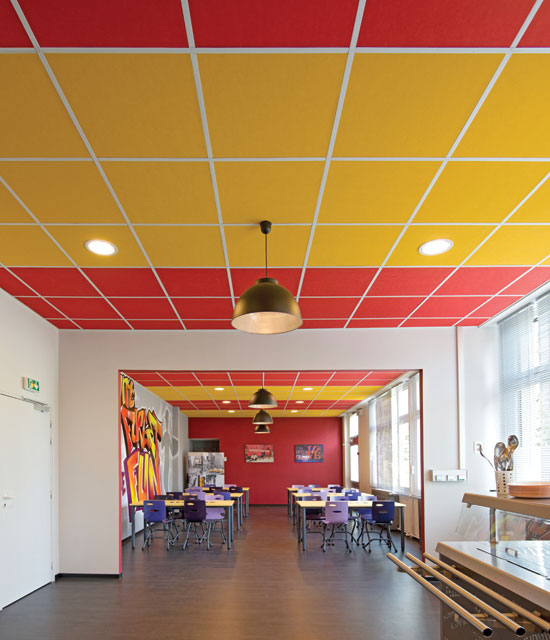
Photo courtesy of ROCKFON
Stone wool ceiling panels can be specified in a wide range of colors for different settings, particularly appropriate in educational settings that still need high acoustical performance.
Surfaces. Unlike many mineral fiber ceiling tiles, fissures are not required in stone wool ceilings to improve sound absorption since the material is naturally sound absorbent. As such, their smooth finish can provide a designer-preferred surface with a clean, uniform look.
Shape and form. Shape in this case refers to the two-dimensional appearance of ceiling tiles such as squares, rectangles, etc. Form refers to the three-dimensional possibilities such as free hanging cubes or other configurations to baffle sound in a space. The current design trend is for more use of large-format planks and three-dimensional elements to give greater design expression to spaces. Stone wool products are available to support these design trends in both shape and form.
Projects: Designing for Specific Building Types
The performance, aesthetics, and design principles of good suspended acoustical ceiling design all come together in particular projects. Of course each building type tends to have its own focus or functional requirements for ceilings as discussed briefly as follows:
Office environments commonly have a strong need for good acoustical control given that there is an often dense area of people working together with a need for a high degree of distraction-free concentration. After surveying 65,000 people over the past decade in North America, Europe, Africa, and Australia, researchers at the University of California, Berkeley, report that more than half of office workers are dissatisfied with the level of “speech privacy,” making it the leading complaint in offices everywhere (The New York Times, May 2012). Other studies have found that there is a close relationship between occupational noise exposure and all-cause mortality with industrial workers (CORDIS study, Melamed et al., 1999). In open office layouts, unwanted noise sources include nearby conversations, benching workstations, speaker phones, etc. which all need to be contained requiring ceiling products with high NRC ratings. Hence, designing spaces to address these acoustical concerns is clearly important and the high performance of stone wool ceilings certainly can contribute to that overall design. Further, the fire safety, durability, aesthetics, and mold resistance address other aspects of modern office design and planning.

Photo courtesy of ROCKFON
Healthcare settings require excellent acoustics, hygiene, cleaning capabilities; stone wool ceilings can provide all three.
In healthcare settings, it is worth noting that sound pressure (decibel) levels in healthcare have risen significantly and consistently since 1960 (study by Busch-Vishniac et al, 2005). In particular, night-time noise pollution is one of the main complaints of patients in hospitals. Modern research suggests that Florence Nightingale wasn't exaggerating when she stated “Unnecessary noise…is the most cruel absence of care which can be inflicted either on sick or well. For…the sick are only mentioned as suffering in a greater proportion than the well from precisely the same causes.” (Notes on Nursing first published in 1860 with a Dover edition printed in 1969). Current studies show that high levels of sound have negative physical and psychological effects on patients, disrupting sleep, increasing stress, and decreasing patients' confidence in the competence of their clinical caregivers who may be suffering from noise issues as well.
Attention to detail and the use of sound-insulating materials coupled with sound absorption in rooms can go a long way toward addressing these concerns. Stone wool ceiling tiles with high NRC ratings will help meet the design criteria for performance. Additionally, the hygienic nature of stone wool that does not allow for mold or other microorganisms to grow helps to ensure a healthcare environment that is appropriately healthy. The smooth surface of stone wool tiles also means that they are easy to clean when needed. The fire safety characteristics and light reflective qualities add to the safety and quality of healthcare spaces as well.
Education settings have been studied extensively when it comes to indoor acoustical quality. One such study concluded that classrooms in the United States typically have speech intelligibility ratings of 75 percent or less, meaning every fourth spoken word is not understood (Seep, Glosemeyer, Hulce, Linn, & Aytar, 2000). Another found that loud or reverberant classrooms may cause teachers to raise their voices, leading to increased teacher stress and fatigue (Tiesler & Oberdörster, 2008). Whether the focus is the students, the teachers, or both, all will benefit from improved acoustical performance in the classroom. High-performance stone wool ceiling tiles can certainly contribute to an overall successful acoustical design in that regard. They can also be very useful in open gathering spaces such as cafeterias, gyms, libraries, and auditorium spaces. The other qualities of stone wool tiles are also desirable for schools as well in that fire safety in corridors, moisture resistance in locker rooms, and overall aesthetic options with colors and patterns are a big part of successful school designs.
Regardless of the building type, all clients are concerned about getting good value at a reasonable cost. Stone wool ceiling tile systems are very competitive with other ceiling systems with an installed price ranging from $2.00 to $5.00 per square foot depending on the usual construction cost variables of location, project size, product features, etc. That means that for essentially the same cost as other suspended ceiling systems, it is possible to have a building that performs better in terms of acoustics, appearance, durability, fire safety, and moisture resistance.
Conclusion
Properly designed and installed, suspended ceiling systems using stone wool ceiling tiles can enhance the design of a variety of building types. As a product, it can provide the needed superior acoustical properties for indoor environments both in terms of sound absorption and sound insulation. Like all such systems, they provide ready access to plenum spaces above the ceiling while contributing to the visual and acoustical aspects of the spaces where they are used. Stone wool specifically can support sustainability initiatives and be long lasting by resisting moisture and corrosion. Further, it can improve fire performance, humidity resistance, energy efficiency, and aesthetics of the overall building.
Peter J. Arsenault, FAIA, NCARB, LEED AP, is a nationally known architect, sustainability consultant, technical writer, and continuing education presenter. www.linkedin.com/in/pjaarch
 |
ROCKFON® and Chicago Metallic have combined forces to offer complete ceiling system solutions. Their stone wool ceiling panels, featuring superior humidity resistance and acoustic control, easy-to-install ceiling suspension systems, and versatile metal ceilings, are among the highest-performing, most cost-effective, and time-efficient available in the market. www.rockfon.com |


